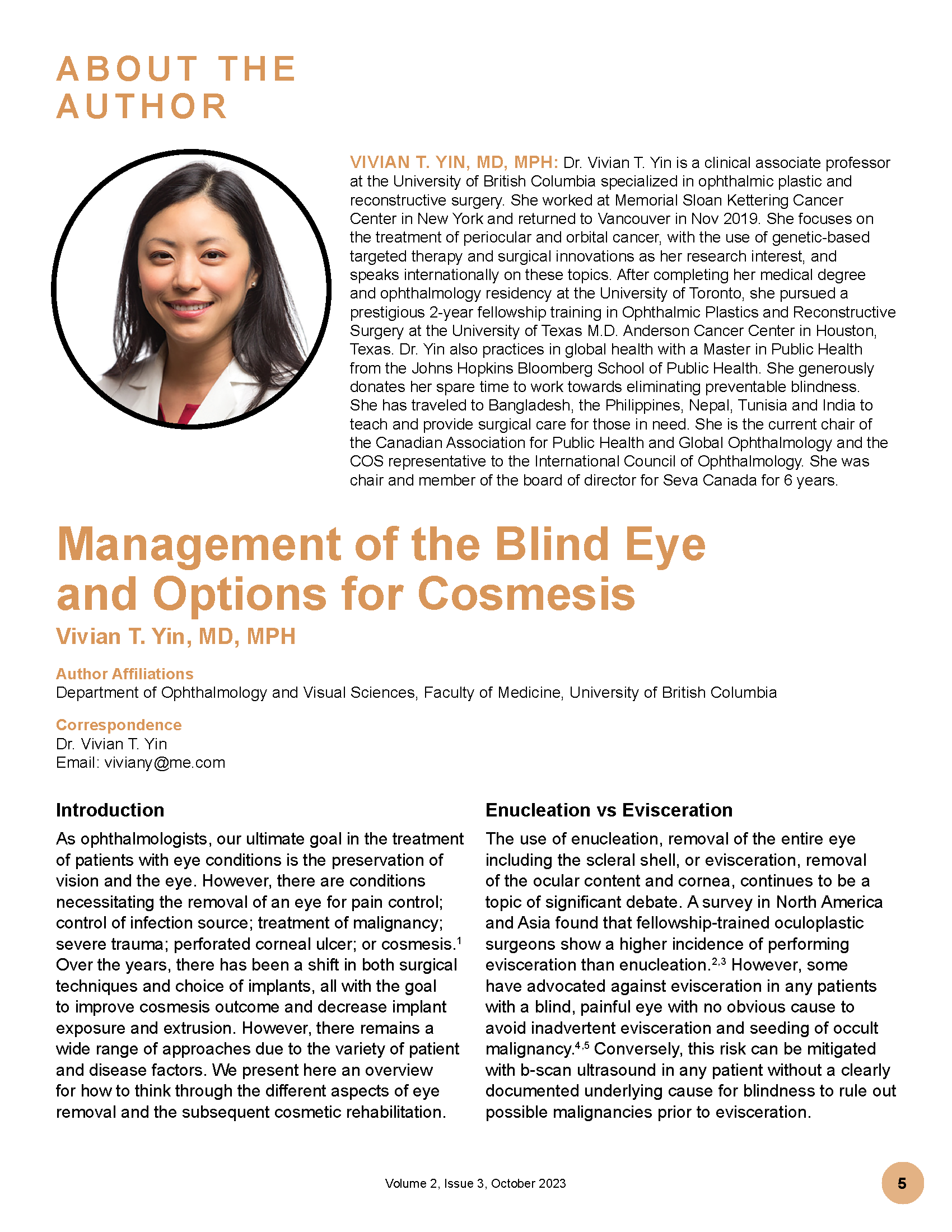Management of the Blind Eye and Options for Cosmesis
Abstract
As ophthalmologists, our ultimate goal in the treatment of patients with eye conditions is the preservation of vision and the eye. However, there are conditions necessitating the removal of an eye for pain control; control of infection source; treatment of malignancy; severe trauma; perforated corneal ulcer; or cosmesis. Over the years, there has been a shift in both surgical techniques and choice of implants, all with the goal to improve cosmesis outcome and decrease implant exposure and extrusion. However, there remains a wide range of approaches due to the variety of patient and disease factors. We present here an overview for how to think through the different aspects of eye removal and the subsequent cosmetic rehabilitation.
References
Sigurdsson H, Thorisdottir S, Bjornsson JK. Enucleation and evisceration in Iceland 1964-1992. Study in a defined population. Acta Ophthalmol Scand. 1998;103-107.
Shah RD, Singa RM, Aakalu VK, et al. Evisceration and enucleation: A national survey of practice patterns in the United States. Ophthalmic Surg Lasers Imaging. 2012;43(5):425-430.
Koh V, Chiam N, Sundar G. Survey of common practices among oculofacial surgeons in the Asian-Pacific region: Evisceration, enucleation and management of anophthalmic sockets. Orbit. 2014;33(6):477.
Eagle RC Jr, Grossniklaus HE, Syed N, et al. Inadvertent evisceration of eyes containing uveal melanoma. Arch Ophthalmol. 2009;127(2):141-145.
Schefler AC, Abramson DH. Should evisceration ever be done in a blind, painful eye? Arch Ophthalmol. 2009;127(2):211-212.
Shams PN, Bohman E, Baker MS, et al. Chronic anophthalmic socket pain treated by implant removal and dermis fat graft. Br J Ophthalmol. 2015;99(12):1692-1696.
Shah-Desai SD, Tyers AG, Manners RM. Painful blind eye: efficacy of enucleation and evisceration in resolving ocular pain. Br J Ophthalmol. 2000;84(4):437-438.
Hogeboom CSE, Mourits DL, Ket JCF, et al. Persistent socket pain post enucleation and post evisceration: A systemic review. Acta Ophthalmol. 2018 Nov;96(7):661-672.
Kilmartin DJ, Dick AD, Forrester JV. Prospective surveillance of sympathetic ophthalmia in the UK and Republic of Ireland. Br J Ophthalmol. 2000 March;84:259-263.
Kilmartin DJ, Dick AD, Forrester JV. Sympathetic ophthalmia risk following vitrectomy: Should we counsel patients? Br J Ophthalmol. 2000;84:448-449.
Jordan DR, Dutton JJ. The rupture blobe, sympathetic ophthalmia, and the 14-day rule. Ophthalmic Plast Reconstr Surg. 2022;38(4):315-324.
Brackup AB, Carter KD, Nerad JA, et al. Long-term follow-up of severely injured eyes following globe rupture. Ophthalmic Plastic Reconstr Surg. 1991;7(3):194-197.
Tripathy D, Rath S. Evisceration with primary orbital implant in fulminant endophthalmitis/panophthalmitis. Orbit. 2015;34(5):279-283.
Tianthong W, Aryasit O. Outcomes of evisceration or enucleation by resident trainees in patients with recalcitrant endophthalmitis or panophthalmisit. Medicine. 2022;101:30.
Hui JI. Outcomes of orbital implants after evisceration and enucleation in patients with enophthalmitis. Curr Opinion Ophthalmol. 2010;21:375-379.
Lin CW, Liao SL. Long-term complications of different porous orbital implants: A 21-year review. Br J Ophthalmol. 2017;101(5):681-685.
Su GW, Yen MT. Current trends in managing the anophthalmic socket after primary enucleation and evisceration. Ophthalmic Plast Reconstr Surg. 2004;20(4):274-280.
Shome D, Honavar SG, Raizada K, et al. Implant and prosthesis movement after enucleation: A randomized controlled trial. Ophthalmol. 2010;117:1638-1644.
Custer PL, Maamari RN, Huecker JB, et al. Anophthalmic ptosis and the effect of enucleation on upper eyelid function. Ophthalmic Plast Reconstr Surg 2021;37(3S):S80-S84.

Downloads
Published
How to Cite
Issue
Section
License
Copyright (c) 2023 Canadian Eye Care Today

This work is licensed under a Creative Commons Attribution-NonCommercial-NoDerivatives 4.0 International License.
